| This article uses bare URLs, which are uninformative and vulnerable to link rot. Please consider converting them to full citations to ensure the article remains verifiable and maintains a consistent citation style. Several templates and tools are available to assist in formatting, such as reFill (documentation) and Citation bot (documentation). (August 2022) (Learn how and when to remove this message) |
| Morelet's crocodile Temporal range: Late Pleistocene–Present, 0.1–0 Ma PreꞒ Ꞓ O S D C P T J K Pg N ↓ | |
|---|---|
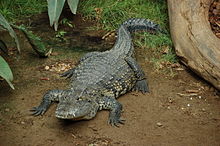
| |
| Conservation status | |
 Least Concern (IUCN 3.1) | |
| CITES Appendix I (CITES) | |
| Scientific classification | |
| Domain: | Eukaryota |
| Kingdom: | Animalia |
| Phylum: | Chordata |
| Class: | Reptilia |
| Clade: | Archosauromorpha |
| Clade: | Archosauriformes |
| Order: | Crocodilia |
| Family: | Crocodylidae |
| Genus: | Crocodylus |
| Species: | C. moreletii |
| Binomial name | |
| Crocodylus moreletii (A.H.A. Duméril & Bibron, 1851) | |

| |
| Range of Crocodylus moreletii | |
Morelet's crocodile (Crocodylus moreletii), also known as the Mexican crocodile or Belize crocodile, is a modest-sized crocodilian found only in the Atlantic regions of Mexico, Belize and Guatemala. It usually grows to about 3 metres (10 ft) in length. It is a species at least concern for extinction according to the International Union for Conservation of Nature. The species has a fossil record in Guatemala.
Taxonomy and etymology
Morelet's crocodile was first described in 1850 in Mexico by the French naturalist Pierre Marie Arthur Morelet. The species was subsequently named after him. It was long confused with the American and Cuban crocodiles because of similar characteristics and an ambiguous type locality. It was not generally accepted as a separate species until the 1920s.
Evolution
The genus Crocodylus likely originated in Africa and radiated outwards towards Southeast Asia and the Americas, although an Australia/Asia origin has also been considered. Phylogenetic evidence supports Crocodylus diverging from its closest recent relative, the extinct Voay of Madagascar, around 25 million years ago, near the Oligocene/Miocene boundary.
Phylogeny
Below is a cladogram based on a 2018 tip dating study by Lee & Yates simultaneously using morphological, molecular (DNA sequencing), and stratigraphic (fossil age) data, as revised by the 2021 Hekkala et al. paleogenomics study using DNA extracted from the extinct Voay.
| Crocodylinae |
| ||||||||||||||||||||||||||||||||||||||||||||||||||||||||||||||||||||||||||||||||||||||||||||||||||||||||||||
Characteristics
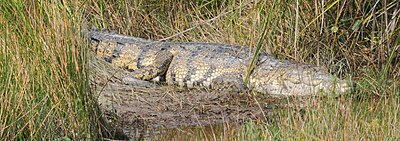

Morelet's crocodile is similar in appearance and morphology to the Cuban and the larger American crocodiles. This species has a broad snout with 66 to 68 teeth when they are fully mature. It is grayish-brown in color with dark bands and spots on the body and tail. This is similar to other crocodiles, like the American crocodile, but the Morelet’s is somewhat darker. Juvenile crocodiles are bright yellow with dark bands. The iris is silvery brown. They have four short legs, giving them a rather sprawling gait, and a long tail, which is used for swimming. The hind feet are webbed. Despite their short legs, they are fast runners.
Morelet's crocodile is smaller than most other crocodiles, though it is larger than the dwarf crocodile (Osteolaemus tetraspis). Adult males are typically larger than females. The average adult Morelet's crocodile is about 2.1 m (6 ft 11 in), with a typical length range of 1.5 to 2.7 m (4 ft 11 in to 8 ft 10 in) (the lower measurement representing the mean total length of a female at sexual maturity which is attained at roughly 7–8 years of age in the wild). Almost all crocodiles in excess of 2.5 m (8 ft 2 in) are males and at this advanced stage of maturity, the male goes through a significant change in skull osteological morphology as the skull appears to increase in broadness and robustness. Large adult males can attain a length of 3 m (10 ft), anything in excess of this is considered exceptionally rare for this species however the species has a maximum reported length of 4.5 m (15 ft), with two other outsized specimens reportedly measuring 4.1 and 4.3 m (13 and 14 ft), respectively. One mature adult specimen measuring 2.84 m (9 ft 4 in) and weighing 110 kg (240 lb) had a bite force of 4,399 N (989 lbf). The weight of a large 3 m (10 ft) wild male crocodile is estimated to average around 150 kg (330+3⁄4 lb), although mass is likely much more in outsized individuals. One large male with a presumed total length of around 3.5 m (11 ft 6 in) weighed about 250 kg (550 lb). Another large individual measuring 3.3 m (10 ft 10 in) in length weighed 180 kg (400 lb).
Distribution and habitat

Morelet's crocodile can be found in freshwater habitats in Central America and along the Gulf of Mexico stretching through Belize, Guatemala, and to Mexico. The Belizean pine forests are an example of the type of ecoregion in which they occur.
In their freshwater habitats, they prefer isolated areas that are secluded. This species of crocodile can mainly be found in freshwater swamps and marshes which are located inland, and in large rivers and lakes. Both of these habitats are forested to help add cover.
The Morelet can also be found along the coast in brackish waters and the grassy savannas on the Yucatán Peninsula. These crocodiles become much more distributed during the rainy seasons when flooding occurs and it is easier for them to move elsewhere.
Juvenile crocodiles live in very dense cover to protect them from other predators that might be in the area and will remain there until they become older and able to fend for themselves. Adult crocodiles are known to dig out burrows during dry seasons in their area. The range of this crocodile can overlap with the American crocodile, which can sometimes lead to them being confused with one another. Morelet's crocodile generally prefers mainland freshwater habitats, while American crocodiles in the shared range are typically found in areas of saline mangrove, often on cays or atolls. Hybridization between the two species has been reported in Mexico and coastal Belize.
Recently, the Morelet's crocodile has been introduced into the Rio Grande (Rio Bravo in Mexico). Several newspaper outlets on the Mexican side of the border report of reptiles inhabiting the river appearing not to be the American alligator which is native to Texas, but the Morelet's crocodile which is native to Tamaulipas from San Fernando southward. Crocodiles have been seen in the cities of Matamoros, Reynosa and as far north as Nuevo Laredo. The sightings have prompted several municipal police departments to put up signs warning people about entering the river.
Biology and behavior
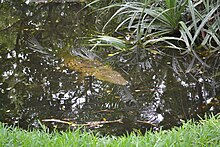
Hunting and diet
Like most crocodilians, Morelet's crocodiles are highly opportunistic and will prey on practically anything that they can overpower that comes in their territories. Juvenile crocodiles feed largely on fish and insects until they become bigger and more capable of bringing down larger prey. Adults largely prey on small mammals, birds, other reptiles and fish, as well as gastropods, crustaceans and other invertebrates. Dogs and goats have been taken by this species, including a record of a 2.9 m (9 ft 6 in) adult killing an English sheepdog which weighed at least 35 kg (77 lb). Adults have also been recorded eating even larger animals, including cattle and tapirs, although these have been cases of scavenging on carcasses, with the tapir having been killed by a jaguar. Crocodiles have been known to be cannibalistic towards smaller specimens. The species has attacked humans on multiple occasions and at least 12 documented human fatalities have occurred. Despite the relatively small size of the species, large adult Morelet's are capable of overpowering a human. Due to partial consumption, recorded fatal attacks are likely predatory rather than defensive in nature. The only natural predator of the Morelet's crocodile is the jaguar. Predation of a Morelet’s crocodile by a jaguar was captured for the first time on a camera trap in the Calakmul Biosphere Reserve of Yucatán, Mexico in 2019.
Reproduction
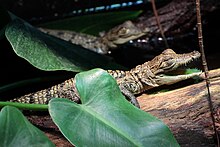
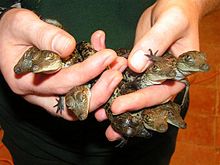
Breeding usually takes place between April and June and the eggs are laid before the start of the rainy season. Morelet's crocodiles are unique among North American crocodiles in that they build mound nests only, and not mound and hole nests. These mound nests are about 3 m (10 ft) wide and 1 m (3 ft 3 in) high and can be found near the water or on floating vegetation. A female crocodile can lay between 20 and 45 eggs and nests have been found containing eggs from more than one female. The eggs are buried and the nests are guarded by females. The eggs usually hatch after 80 days of incubation and hatchlings are normally about 17 cm (6+1⁄2 in) long. After the eggs have hatched the female crocodile will carry her young to the water, where they are protected by both parents. Females are highly protective of their young and have reportedly been observed to aggressively displace intruders and humans if distress calls of the baby crocodiles are heard and even father crocodiles have been observed to spring to the defense of young crocodiles. In captivity, juvenile crocodiles—but never hatchlings—are treated aggressively by adult crocodiles.
Conservation
Morelet's crocodile has long been threatened by habitat destruction and illegal hunting. Both of these factors have significantly lowered their populations. It was hunted for its hide during the 1940s and 1950s because high-quality leather can be made from their skins.
Notes
- Except populations of Belize and Mexico which are included in Appendix II.
References
- Rio, Jonathan P.; Mannion, Philip D. (6 September 2021). "Phylogenetic analysis of a new morphological dataset elucidates the evolutionary history of Crocodylia and resolves the long-standing gharial problem". PeerJ. 9: e12094. doi:10.7717/peerj.12094. PMC 8428266. PMID 34567843.
- ^ Platt, S.G.; Sigler, L.; Rainwater, T.R.; Cedeño-Vázquez, J.R.; Villegas, A. (2023). "Crocodylus moreletii". IUCN Red List of Threatened Species. 2023: e.T5663A193672551. doi:10.2305/IUCN.UK.2023-1.RLTS.T5663A193672551.en. Retrieved 1 April 2024.
- "Appendices | CITES". cites.org. Retrieved 2022-01-14.
- "Crocodylus moreletii ". The Reptile Database. www.reptile-database.org.
- ^ "Crocodilians species (CSG)". Archived from the original on 2009-07-26.
- "Crocodylus moreletii Dumeril and Bibron 1851 (Morelet's crocodile)". PBDB.
- ^ Britton, Adam (2009). "Crocodylus moreletii (BIBRON & DUMERIL, 1851)". Crocodilians Natural History and Conservation. Howard Springs, Australia.
- Beolens, B.; Watkins, M.; Grayson, M. (2011). The Eponym Dictionary of Reptiles. Baltimore: Johns Hopkins University Press. xiii + 296 pp. ISBN 978-1-4214-0135-5. (Crocodylus moreletii, pp. 182-183).
- ^ Hekkala, E.; Gatesy, J.; Narechania, A.; Meredith, R.; Russello, M.; Aardema, M. L.; Jensen, E.; Montanari, S.; Brochu, C.; Norell, M.; Amato, G. (2021-04-27). "Paleogenomics illuminates the evolutionary history of the extinct Holocene "horned" crocodile of Madagascar, Voay robustus". Communications Biology. 4 (1): 505. doi:10.1038/s42003-021-02017-0. ISSN 2399-3642. PMC 8079395. PMID 33907305.
- Oaks, Jamie R. (2011). "A time-calibrated species tree of Crocodylia reveals a recent radiation of the true crocodiles". Evolution. 65 (11): 3285–3297. doi:10.1111/j.1558-5646.2011.01373.x. PMID 22023592. S2CID 7254442.
- Michael S. Y. Lee; Adam M. Yates (27 June 2018). "Tip-dating and homoplasy: reconciling the shallow molecular divergences of modern gharials with their long fossil". Proceedings of the Royal Society B. 285 (1881). doi:10.1098/rspb.2018.1071. PMC 6030529. PMID 30051855.
- Guggisberg, C.A.W. (1972). Crocodiles: Their Natural History, Folklore, and Conservation. Newton Abbot: David & Charles. p. 195. ISBN 0-7153-5272-5.
- ^ Platt, S. G., Rainwater, T. R., Thorbjarnarson, J. B., Finger, A. G., Anderson, T. A., & McMurry, S. T. (2009). Size estimation, morphometrics, sex ratio, sexual size dimorphism, and biomass of Morelet’s crocodile in northern Belize. Caribbean Journal of Science, 45(1), 80-93.
- Barrios-Quiroz, G., Casas-Andreu, G., & Escobedo-Galván, A. H. (2012). Sexual size dimorphism and allometric growth of Morelet's crocodiles in captivity. Zoological Science, 29(3), 198-203.
- Platt, S.G. (1996). The ecology and status Morelet’s crocodile in Belize. Unpublished PhD Thesis, Clemson University, USA.
- ^ ""Morelet's Crocodile." Belize Zoo. 2007". Archived from the original on 2007-10-13.
- Erickson, Gregory M.; Gignac, Paul M.; Steppan, Scott J.; Lappin, A. Kristopher; Vliet, Kent A.; Brueggen, John D.; Inouye, Brian D.; Kledzik, David; Webb, Grahame J. W. (14 March 2012). "Insights into the Ecology and Evolutionary Success of Crocodilians Revealed through Bite-Force and Tooth-Pressure Experimentation". PLOS ONE. 7 (3): e31781. Bibcode:2012PLoSO...731781E. doi:10.1371/journal.pone.0031781. PMC 3303775. PMID 22431965.
- "ADW: Crocodylus moreletii: CLASSIFICATION".
- Details of a fatal attack on a human by a Morelet's crocodile (Crocodylus moreletii) in Belize. Brandon Sideleau. p. 30.
- Webb, G. (2009). "First record of a Morelet's crocodile in the Grijlava River, Chiapas, Mexico" (PDF). Crocodile Specialist Group Newsletter. 28 (2). IUCN - Species Survival Commission: 14.
- Dever, J. A; Richard E. Strauss; Thomas R. Rainwater; Scott T. McMurry; Llewellyn D. Densmore III (2002). "Genetic Diversity, Population Subdivision, and Gene Flow in Morelet's Crocodile (Crocodylus moreletii) from Belize, Central America". Copeia. 2002 (4): 1078–1091. doi:10.1643/0045-8511(2002)002[1078:GDPSAG]2.0.CO;2.
- C. Michael Hogan; World Wildlife Fund (2012). M. McGinley (ed.). "Belizean pine forests". Encyclopedia of Earth. Washington DC.
- ^ ""Freshwater Crocodile." Australia Zoo". Archived from the original on 2014-02-27. Retrieved 2007-12-14.
- ^ Navarro, Carlos. ""The Return of the Morelet's Crocodile." Reptilia" (PDF). Archived from the original (PDF) on 2016-03-04. Retrieved 2007-12-14.
- Archived at Ghostarchive and the Wayback Machine: "Capturan un cocodrilo en el Río Bravo; alertan sobre peligro". YouTube. 10 December 2012.
- http://www.hoytamaulipas.net/index.php?v1=notas&v2=48248
- "El Nuevo Diario". Archived from the original on 2014-09-06. Retrieved 2014-09-04.
- "Capturan a cocodrilo en casa de Tamaulipas".
- "Gators at busy Matamoros shopping center : News : ValleyCentral.com". Archived from the original on 2014-09-05.
- "Reportan avistamientos de cocodrilos en las lagunas de la JAD de Matamoros - Hora Cero". Archived from the original on 2014-09-05. Retrieved 2014-09-04.
- "Capturan cocodrilo en el Río Bravo".
- "Alertan en Reynosa por presencia de cocodrilos en río Bravo". Archived from the original on 2014-09-04. Retrieved 2014-09-04.
- "Side Step - Reynosa 'alligator' could be a crocodile". 16 September 2008.
- "Reynosa man earns nickname 'Crocodile Hunter' : News : ValleyCentral.com". Archived from the original on 2014-09-05.
- "Reynosa family finds crocodile in their home : News : ValleyCentral.com". Archived from the original on 2014-09-05.
- "Fishermen catch crocodile in Rio Grande". NBC News. 9 October 2006.
- "The San Diego Union-Tribune - San Diego, California & National News".
- "Para acabarla de amolar, crecida de agua trae víboras, lagartos y alimañas".
- ^ Platt, S. G., Rainwater, T. R., Finger, A. G., Thorbjarnarson, J. B., Anderson, T. A., & McMurry, S. T. (2006). Food habits, ontogenetic dietary partitioning and observations of foraging behaviour of Morelet's crocodile (Crocodylus moreletii) in northern Belize. The Herpetological Journal, 16(3), 281-290.
- "Crocodilian Species - Morelet's Crocodile (Crocodylus moreletii)".
- Pérez-Higareda, G., Rangel-Rangel, A., Smith, H. M., & Chiszar, D. (1989). Comments on the food and feeding habits of Morelet's Crocodile. Copeia, 1039-1041.
- Platt, S. G., Rainwater, T. R., Snider, S., Garel, A., Anderson, T. A., & McMurry, S. T. (2007). Consumption of large mammals by Crocodylus moreletii: field observations of necrophagy and interspecific kleptoparasitism. The Southwestern Naturalist, 52(2), 310-317.
- "OpenDataSoft — CrocBITE Live Feed". Archived from the original on 2017-08-13.
- Sideleau (2014). Details of a fatal attack on a human by a Morelet's crocodile (Crocodylus moreletii) in Belize. IUCN Crocodile Specialist Group Newsletter 07/2014; 33(2):29.
- Marlin, J. A., Marlin, K. K., & Platt, S. G. (1995). A documented case of an attack by Morelet's crocodile (Crocodylus moreletii) on man. Bull Chicago Herp Soc, 30, 165-167.
- Sideleau, B., & Britton, A. R. C. (2012). A preliminary analysis of worldwide crocodilian attacks. In Crocodiles Proceedings of the 21st Working Meeting of the IUCN-SSC Crocodile Specialist Group. Gland, Switzerland: IUCN (pp. 111-114).
- Simá-Pantí, David E.; Contreras-Moreno, Fernando M.; Mayor, Carlos Coutiño-Cal y; Zúñiga-Morales, José A.; Martin, Gabriela Méndez-Saint; Reyna-Hurtado, Rafael A. (2020-03-04). "Morelet's crocodile predation by jaguar in the Calakmul Biosphere Reserve in southeastern México". Therya Notes. 1: 8–10. doi:10.12933/therya_notes-20-3. ISSN 2954-3614.
- Álvarez del Toro, M. and Sigler L. (2001). Los Crocodylia de México. IMRNR-PROFEPA: México, D.F.
- Rainwater, T.R., McMurry, S.T. and Platt, S.G. (2000). Crocodylus moreletii (Morelet’s crocodile) behavior. Herpetological Review 31: 237.
- Hunt, R. H. (1977). Aggressive behavior by adult morelet's crocodiles Crocodylus moreleti toward young. Herpetologica, 195-201.
- ^ Espinosa, Eduardo (1998). "Crocodylus Moreletii." Florida Museum. ISBN 9782831704418.
- Platt, Steven; John Thorbjarnarson. “Population status and conservation of Morelet’s Crocodile, Crocodylus moreletii, in northern Belize” Biological Conservation. 2000. 96: 21-29.
- King, F. ""The Crocodile Specialist Group." Crocodile Specialist Group. 4 Mar. 2002". Archived from the original on 2007-12-28.
External links
- "Crocodile Sighting in Corpus Christi"
- "Species Name" Morelets Crocodile; Outcome: Fatal" Archived 2017-08-13 at the Wayback Machine—CrocBITE Live Feed
- Britton, Adam. "How Long Do Crocodiles Live for?" Crocodilian Conservation Database. 2002.
| Extant Crocodilian species | |||||||||||||||||
|---|---|---|---|---|---|---|---|---|---|---|---|---|---|---|---|---|---|
| |||||||||||||||||
| |||||||||||||||||
| |||||||||||||||||
| Taxon identifiers | |
|---|---|
| Crocodylus moreletii | |
- IUCN Red List least concern species
- Crocodylidae
- Reptiles of Mexico
- Reptiles of Belize
- Reptiles of Guatemala
- Reptiles of the Caribbean
- Least concern biota of Mexico
- Least concern biota of North America
- Reptiles described in 1851
- Taxa named by Auguste Duméril
- Taxa named by Gabriel Bibron
- Crocodilians of North America
- Apex predators